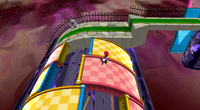Dark matter: Difference between revisions
From the Super Mario Wiki, the Mario encyclopedia
Jump to navigationJump to search
mNo edit summary |
m (Robot: Automated text replacement (-{{llquote +{{quote2)) |
||
| Line 1: | Line 1: | ||
{{distinguish|Poisoned Water|Toxic Cloud}} | {{distinguish|Poisoned Water|Toxic Cloud}} | ||
{{ | {{quote2|The dark matter is eating holes in space! Watch out for those holes, or [[Mario|you'll]] fall into that dark matter!|[[Luma (species)|Luma]]|[[Super Mario Galaxy]]}} | ||
[[File:SMG Dark Matter Plant Platforms.png|thumb|right|200px|Dark Matter.]] | [[File:SMG Dark Matter Plant Platforms.png|thumb|right|200px|Dark Matter.]] | ||
[[File:Darkmatterpools.PNG|thumb|left|200px|Dark Matter has eaten away square-shaped holes in these platforms.]] | [[File:Darkmatterpools.PNG|thumb|left|200px|Dark Matter has eaten away square-shaped holes in these platforms.]] | ||
Revision as of 17:39, May 20, 2017
- Not to be confused with Poisoned Water or Toxic Cloud.
File:Darkmatterpools.PNG
Dark Matter has eaten away square-shaped holes in these platforms.
Dark Matter is an obstacle in Super Mario Galaxy, which appears in Bowser's Dark Matter Plant. It can be found in patches, and has a swirly, purple and black appearance to it; its appearance is similar to Poisoned Water. In the sequel, Super Mario Galaxy 2, it is found rarely in the game. One of its two appearances was the Daredevil Run for Bowser Jr.'s Boom Bunker and the other was Purple Pond Planet from the Cloudy Court Galaxy. A Mattermouth will eat the Dark Matter away.
If Mario or Luigi touch any Dark Matter, they disintegrate and lose a life. Dark Matter can also burn holes in the ground that make Mario or Luigi lose a life should they fall into one.
Trivia
- In reality, Dark Matter is a theoretical substance that takes up a significant portion of the universe and explains how the outer edges of a galaxy move faster than projected in their rotation curve. It does not emit nor absorb a significant level of radiation of any sort, making it difficult to detect.
